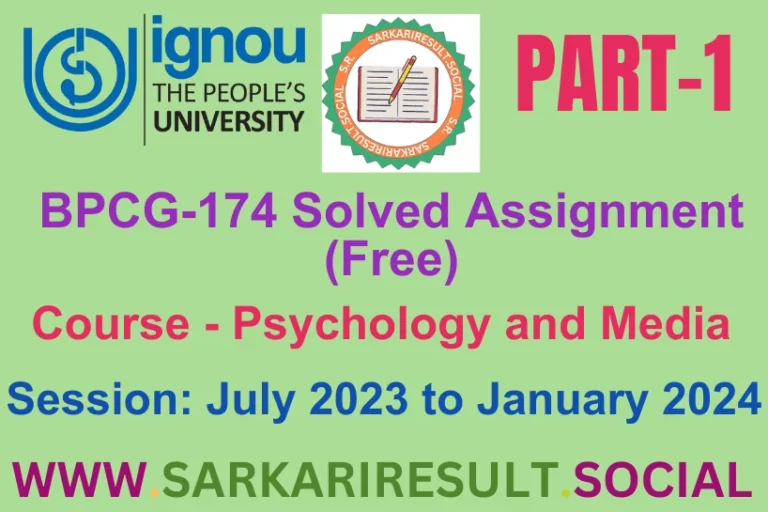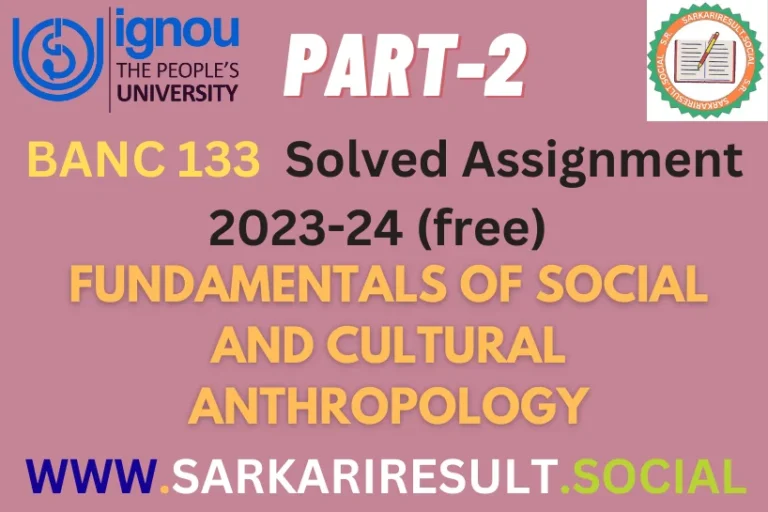Check “Best” BPCG 172 IGNOU Solved Assignment (FREE) 2023-24
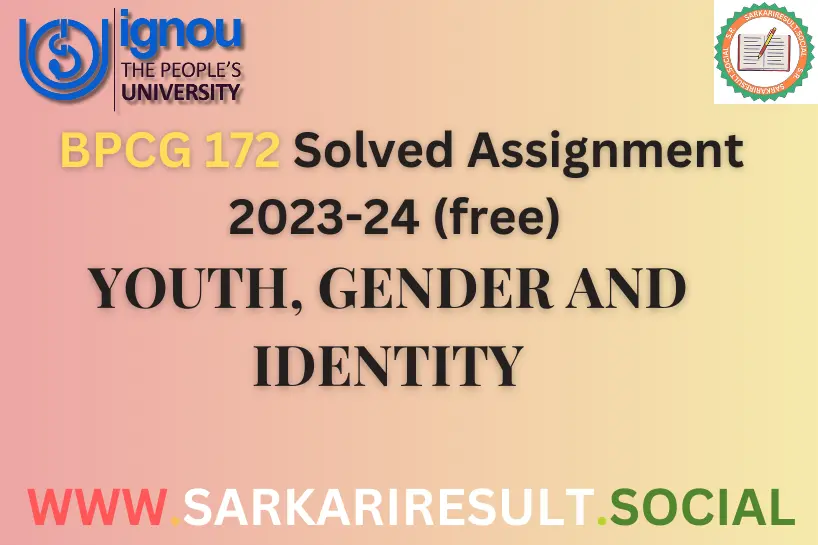
BPCG 172 IGNOU Solved Assignment (FREE) 2023-24
Looking for solved assignments for IGNOU BPCG-172: YOUTH, GENDER AND IDENTITY course in 2023-24? Access comprehensive solved ignou assignments on Sarkari Result! Our meticulously prepared assignments are tailored for this course, helping you excel in your studies. With reliable and accurate answers, you can confidently complete assignments and deepen your understanding of youth, gender, and identity. Our expert-crafted content saves time and energy, allowing you to focus on mastering essential concepts. Maximize your academic performance and gain a competitive edge with our comprehensive resources.
The BPCG-172: YOUTH, GENDER AND IDENTITY course is part of the second semester of the BA Hons. Psychology program. It carries 6 credits, with each credit equivalent to 30 study hours. This means that learners are expected to dedicate 180 hours to complete the course, including reading, preparing assignments, and making notes.
The course is a Generic Elective (GE), which means that students from any discipline can enroll in it. Its main focus is to provide an understanding of youth, particularly in relation to gender and identity. The course explores the development of identity in young individuals, with a specific emphasis on gender and sexuality. Additionally, it covers topics such as youth culture, the influence of media and globalization on youth, and the various challenges faced by young people.
Questions and Answers (Solved)
(Section-A)

Q.1 Define identity. Discuss the theories of identity.(500 words)
Ans. Identity refers to the unique set of characteristics, traits, beliefs, and values that define an individual or a group and differentiate them from others. It encompasses various aspects such as personal, social, cultural, and psychological dimensions. The concept of identity has been explored through several theories, including:
Identity refers to the unique set of characteristics, traits, beliefs, and values that define an individual or a group and differentiate them from others. It encompasses various aspects such as personal, social, cultural, and psychological dimensions. The concept of identity has been explored through several theories, including:
- Psychosocial Theory (Erik Erikson): According to Erikson, identity formation is a lifelong process influenced by social interactions and personal experiences. He proposed that individuals go through different stages of development, with each stage presenting a unique challenge to establish a coherent identity.
- Social Identity Theory (Henri Tajfel): Tajfel’s theory focuses on how individuals define themselves based on their membership in social groups. It suggests that people strive for a positive social identity by categorizing themselves into in-groups (groups they identify with) and out-groups (groups they perceive as different).
- Self-Categorization Theory (John Turner): Building upon Tajfel’s work, Turner’s theory suggests that individuals categorize themselves into social groups to maintain a positive self-concept. It emphasizes the importance of group membership in shaping one’s identity and behavior.
- Identity Theory (Sheldon Stryker): Stryker’s theory emphasizes the influence of social roles and relationships on identity. It suggests that individuals develop identities based on their positions in society and the expectations associated with those roles.
- Intersectionality (Kimberlé Crenshaw): Intersectionality theory recognizes that an individual’s identity is shaped by multiple social categories, such as race, gender, class, and sexuality. It highlights how these intersecting identities can result in unique experiences of privilege or discrimination.
- Narrative Identity Theory (Dan P. McAdams): McAdams proposes that individuals construct their identities through personal narratives. Our life stories, shaped by memories and interpretations, play a crucial role in how we perceive ourselves and make sense of our experiences.
Q.2 Discuss gender socialization and changing gender roles. Provide two examples of this in your family
and surrounding.(500 words)
Ans. Gender socialization refers to the process by which individuals learn and internalize societal norms, expectations, and behaviors associated with their assigned gender. It occurs through various socializing agents such as family, peers, media, and education systems. These socializing agents reinforce traditional gender roles, which dictate the expected behaviors and responsibilities of males and females in a given society.
In recent years, there has been a growing recognition of the need to challenge and redefine traditional gender roles. This shift is driven by the understanding that gender is not solely determined by biological sex but is also a social construct that can be fluid and diverse. Changing gender roles involve breaking free from rigid expectations and allowing individuals to express their gender identity authentically. This can be seen through the following examples:
Example 1 – Family: In my family, my cousin Sarah has challenged traditional gender roles by pursuing a career in engineering. In the past, engineering was considered a predominantly male field, but Sarah’s passion and determination led her to break that stereotype. She received support from her parents, who encouraged her interest in science and technology from a young age. Sarah’s success in her field has inspired other young girls in our family to consider non-traditional career paths, challenging the notion that certain professions are limited to specific genders.
Example 2 – Surroundings: In my community, there is a local organization that focuses on promoting gender equality and empowering women. They organize workshops and events aimed at challenging societal norms and stereotypes. One particular event I attended was a panel discussion on women in leadership roles. The panel consisted of successful women from diverse backgrounds who shared their experiences and challenges in breaking through gender barriers. By providing role models and creating spaces for dialogue, this organization is actively working towards changing gender roles and encouraging women to pursue leadership positions traditionally dominated by men.
These examples illustrate how gender socialization and changing gender roles can manifest in both personal and societal contexts. By challenging traditional expectations and promoting inclusivity, we can create a more equitable society where individuals have the freedom to express their gender identity and pursue their aspirations, regardless of societal norms. It is through these efforts that we can strive for a more diverse, inclusive, and accepting world.
(Section-B)
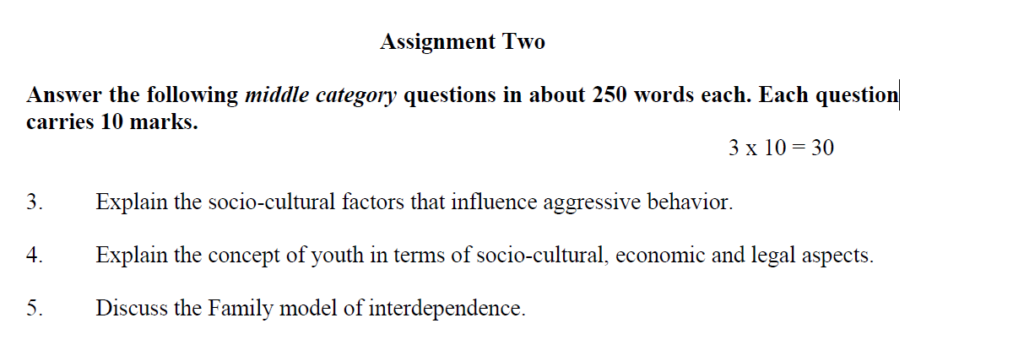
Q.3 Explain the socio-cultural factors that influence aggressive behavior.
Ans. Aggressive behavior is influenced by various socio-cultural factors that shape how individuals perceive, express, and respond to aggression. These factors include:
- Cultural Norms: Cultural norms play a significant role in determining acceptable and unacceptable forms of aggression. Some cultures may condone or even encourage aggressive behavior as a means of resolving conflicts or asserting dominance. Conversely, cultures that prioritize non-violence and peaceful conflict resolution tend to discourage aggressive behavior.
- Socialization: The process of socialization within families, peer groups, and communities heavily influences aggressive behavior. Observing and imitating aggressive models, receiving rewards or punishments for aggressive actions, and being exposed to violence in media can all contribute to the development of aggressive tendencies.
- Parenting Style: Parenting practices, such as harsh discipline, inconsistent discipline, or lack of emotional support, can contribute to the development of aggression in children. Authoritarian or neglectful parenting styles have been associated with increased aggression, while authoritative parenting, characterized by warmth and clear boundaries, can reduce aggressive behavior.
- Peer Influence: Peers play a crucial role in shaping aggressive behavior. Associating with aggressive peers and being part of social groups that support and reinforce aggressive behavior can increase the likelihood of engaging in aggressive acts. Peer pressure and the need to fit in may also contribute to aggression.
- Media and Technology: Exposure to violent media, including movies, video games, and online content, can desensitize individuals to aggression and normalize aggressive behavior. Violent media can also provide models of aggression that individuals may imitate.
- Socioeconomic Factors: Socioeconomic factors, such as poverty, inequality, and limited access to resources, have been linked to increased aggression. Stressors associated with low socioeconomic status can contribute to frustration and aggression.
Q.4 Explain the concept of youth in terms of socio-cultural, economic and legal aspects.
Ans. The concept of youth encompasses various socio-cultural, economic, and legal aspects that shape the experiences and roles of individuals during a specific stage of their lives.
Socio-cultural aspect: In socio-cultural terms, youth refers to the period between childhood and adulthood, typically associated with adolescence and early adulthood. It is a time of personal development, self-discovery, and identity formation. Societies often have specific expectations, norms, and values that define youth, such as educational pursuits, exploration, and peer relationships. Cultural factors, including traditions, beliefs, and socialization practices, influence the experiences of young people within their communities.
Economic aspect: From an economic perspective, youth is often characterized by transitions, such as entering the workforce or pursuing higher education. Economic opportunities and challenges differ across societies and can impact the financial independence, career prospects, and socioeconomic status of young individuals. Youth unemployment, job market conditions, and access to resources and training programs play a significant role in shaping the economic aspect of youth.
Legal aspect: The legal aspect of youth focuses on the rights, responsibilities, and legal frameworks governing young individuals. Laws related to education, labor, marriage, voting, and criminal justice often include age-specific regulations. These laws aim to protect the well-being and rights of young people while also recognizing their increasing autonomy and capacity to make decisions. Legal frameworks vary across countries and may reflect cultural values, social norms, and the evolving understanding of youth development.
Overall, the concept of youth encompasses socio-cultural, economic, and legal dimensions that influence the experiences and trajectories of young individuals. Recognizing these multifaceted aspects is essential for understanding and addressing the specific needs, challenges, and opportunities that young people encounter as they navigate their transition into adulthood.
Q.5 Discuss the Family model of interdependence.
Ans. The Family model of interdependence emphasizes the interconnectedness and mutual reliance among family members. In this model, the family unit is viewed as a cohesive system where the well-being of each individual is intertwined with the well-being of the whole family. Key aspects of the Family model of interdependence include:
- Emotional Support: Family members provide emotional support, care, and nurturance to one another. They create a safe and supportive environment where individuals can express their feelings, seek guidance, and find comfort during challenging times.
- Shared Responsibilities: Family members share various responsibilities and tasks, such as household chores, financial management, and childcare. The distribution of responsibilities is based on the strengths and abilities of each family member, fostering cooperation and collaboration within the family.
- Decision-making: In the Family model of interdependence, important decisions are made collectively, taking into account the opinions, needs, and preferences of each family member. Decision-making is guided by open communication, mutual respect, and a desire to maintain harmony and well-being for all.
- Interconnected Goals: Family members work together towards common goals and aspirations, such as education, career success, and overall family stability. Individual achievements are celebrated as a collective accomplishment, reflecting the shared investment in each other’s success.
- Intergenerational Support: The Family model of interdependence recognizes the importance of intergenerational relationships and support. Family members provide assistance and guidance to younger or older generations, creating a sense of continuity, respect, and appreciation for the wisdom and experiences of each age group.
(Section-C)
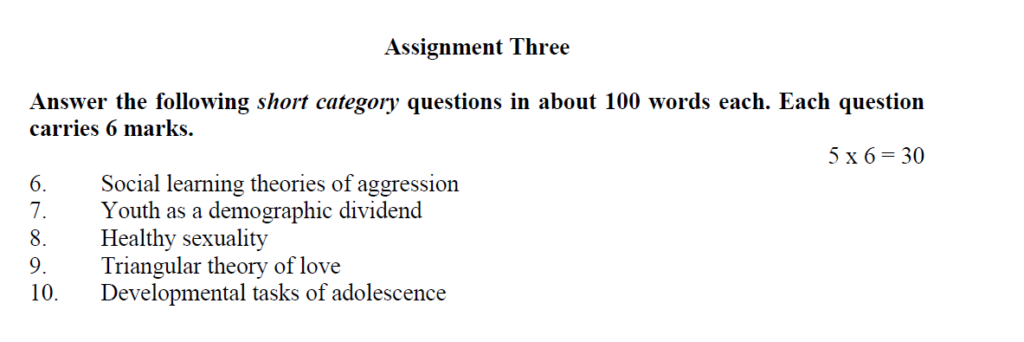
Q.6 Social learning theories of /aggression.
Ans. Social Learning Theories of Aggression: Social learning theories propose that aggression is learned through observation, imitation, and reinforcement. Individuals acquire aggressive behaviors by observing aggressive models, such as family members or peers, and imitating their actions. They may also be influenced by the rewards or punishments associated with aggressive behavior. These theories highlight the role of socialization and the environment in shaping aggressive tendencies.
Q.7 Youth as a demographic dividend.
Ans. Youth as a Demographic Dividend: The term “youth as a demographic dividend” refers to the positive potential that young people can bring to society and the economy. It recognizes that a large youth population can be an asset if their needs, such as education, health, and employment, are effectively addressed. When provided with the right opportunities and investments, youth can contribute to economic growth, innovation, and social development, benefiting both individuals and society as a whole.
Q.8 Healthy sexuality.
Ans. Healthy Sexuality: Healthy sexuality refers to a positive, respectful, and responsible approach to sexual attitudes, behaviors, and relationships. It involves having accurate information about sexual health, consent, contraception, and safe practices. Healthy sexuality emphasizes open communication, mutual respect, and consent in sexual relationships. It also encompasses the recognition of diverse sexual orientations, gender identities, and the importance of sexual well-being for overall mental and physical health.
Q.9 Triangular Theory of Love.
Ans. Triangular Theory of Love: The Triangular Theory of Love, proposed by psychologist Robert Sternberg, describes love as consisting of three components: intimacy, passion, and commitment. Intimacy refers to emotional closeness and connection, passion involves physical and sexual attraction, and commitment represents the decision to maintain the relationship. Different combinations of these components result in different types of love, such as romantic love (intimacy and passion), companionate love (intimacy and commitment), and consummate love (all three components).
Q.10 Developmental Tasks of Adolescence.
Ans. Developmental Tasks of Adolescence: Developmental tasks of adolescence are the psychological and social challenges that individuals typically face during this transitional period. These tasks include establishing a sense of identity, developing autonomy and independence, forming healthy relationships with peers and romantic partners, exploring career options, and acquiring life skills. Successfully navigating these tasks contributes to healthy development and the transition into adulthood. However, the completion of these tasks can vary based on individual experiences, cultural factors, and support systems available.
Disclaimer
The following questions and answers BPCG 172 Ignou Solved Assignment (FREE) 2023-24 have been provided for informational purposes only. While efforts have been made to provide accurate and up-to-date information, the content should not be considered as professional advice. Users are encouraged to verify any information independently. The website and its operators do not assume any liability for the use or interpretation of the content provided. Visitors are advised to consult relevant experts or professionals for specific guidance and assistance. By using this website, you agree that the website and its operators are not responsible for any consequences arising from the use of the information provided. Thank you !!!

